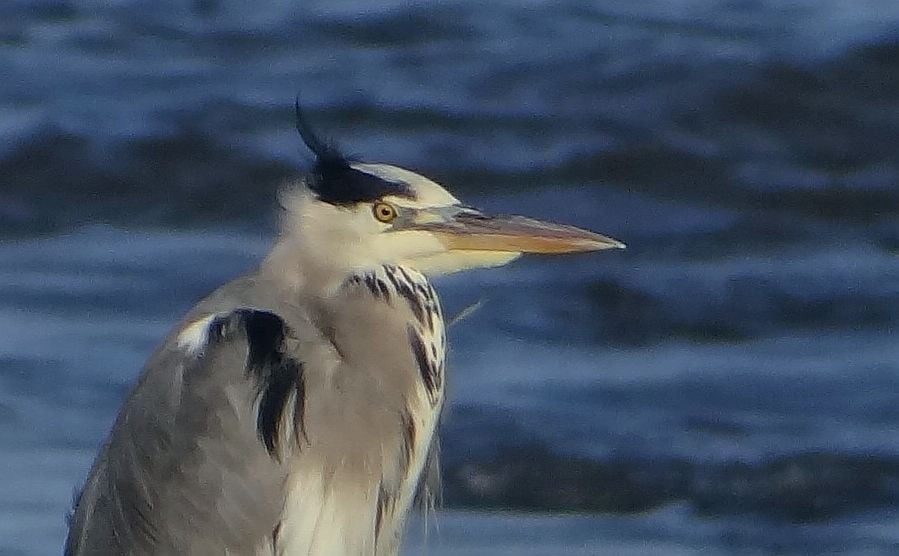Nature Watch, Your Flora and Fauna Photos and Stories
Hetcins1
·NOTSHARP
·BLOW UP
·sxl2004
·Talking about Herons, I recently steered an eight rowing boat into a hanging tree because I saw a big Heron and did not pay attention to the direction of the boat …….🙁😀
NOTSHARP
·Stunning plumage, I'm guessing that's North America? Our European/Eurasian grey heron looks very different from this one, they're really huge with about a 2-meter or 6.5-foot wingspan (looking a bit like a pterodactyl in flight) actually your Gray heron looks quite a lot like the rare blue heron here in the UK. I think we have about 7 or 8 different herons, but I'm pretty sure we don't have these guys..
I am in the UK. NE Scotland, on the Moray Firth. I have never seen any other than Greys up here, and often see one or two on the shore when the tided are right.
Plumage may look different because it was being ruffled by a very stiff breeze.
They are big birds, and impressive in flight.
Steve.
NOTSHARP
·BLOW UP
·I am in the UK. NE Scotland, on the Moray Firth. I have never seen any other than Greys up here, and often see one or two on the shore when the tided are right.
Plumage may look different because it was being ruffled by a very stiff breeze.
They are big birds, and impressive in flight.
Steve.
That's a lovely shot!
Do you think they get longer plumage being far up north??
I've seen large white herons and small white herons AKA Great White Egret and Little Egrets:


I've never (knowingly) seen a Blue Heron they're very rare:

We have these Eurasian Bittens living very locally (London), but I've never seen them they're very elusive, although I have heard them making very deep bellowing calls:

I've not seen a little Bittern:

I have seen Cattle Egrets

And I'd really love to see a Purple Heron, but never seen one here in the UK:

(not my pictures unfortunately)
BLOW UP
·actually there's even more Herons than my thought, this link is really good: https://birdfact.com/articles/herons-in-the-uk
ErichPryde
··Seamasters ForeverProbably not, normally birds show a decrease in wing size and increase in body mass (to maximize square-cube ratio and retain heat- wings make good radiators!) in colder climate populations, vs warmer climate populations of the same bird, where the inverse is true (per Bergmann's and Allen's rules). If these are non-migratory birds (I don't know much about Gray herons), or non-migratory populations, I wouldn't expect larger wings or flight feathers, but it's possible the birds themselves are just in general larger.
BLOW UP
·Probably not, normally birds show a decrease in wing size and increase in body mass (to maximize square-cube ratio and retain heat- wings make good radiators!) in colder climate populations, vs warmer climate populations of the same bird, where the inverse is true (per Bergmann's and Allen's rules). If these are non-migratory birds (I don't know much about Gray herons), or non-migratory populations, I wouldn't expect larger wings or flight feathers, but it's possible the birds themselves are just in general larger.
Actually I think the very full plumage example that Notsharp originally posted looks a fair bit smaller than the grey herons we get down south (normally at least a meter in height) although he/she is looking like they're trying to keep warm so possibly compacted as much as possible.
I wouldn't imagine the wings are larger, or have longer or fuller flight feathers,
Canuck
·One thing you learn about orchids is that they have a mind of their own as to when and how often to bloom. This one hasn’t bloomed for 5 or 6 years. But it is important to not give up! My spouse knows the species name for this one, but IIRC, it is called “Tinker Bell”. We were hoping it would be in bloom for her ladyship’s birthday on Oct. 16.
Edited to correct the aforementioned name. It is known as Jimminy Cricket.
Edited to correct the aforementioned name. It is known as Jimminy Cricket.
Edited:
BLOW UP
·Bank robber runs into a banky suits into the seating everybody hits the
In my experience with orchids, to get them to flower, I shock them.
That is to say, I usually water them using total immersion, once a week with half a dosage of Orchid fertilizer, if I want them to flower, I'll miss out the watering altogether for an amount of time, so they start to go a little bit droopy (but not too much) that seems to trigger an emergency response, as they might die imminently, they then usually send out a flower spike then, then, I resume water and fertilizer as usual. The other thing that has worked for me is changing their temperature dramatically, so from the usual warm sunny spot, I'll put them in a cool spot for a little while in my experience that can also trigger flowering.
One thing you learn about orchids is that they have a mind of their own as to when and how often to bloom. This one hasn’t bloomed for 5 or 6 years. But it is important to not give up! My spouse knows the species name for this one, but IIRC, it is called “Tinker Bell”. We were hoping it would be in bloom for her ladyship’s birthday on Oct. 16.
Edited to correct the aforementioned name. It is known as Jimminy Cricket.
In my experience with orchids, to get them to flower, I shock them.
That is to say, I usually water them using total immersion, once a week with half a dosage of Orchid fertilizer, if I want them to flower, I'll miss out the watering altogether for an amount of time, so they start to go a little bit droopy (but not too much) that seems to trigger an emergency response, as they might die imminently, they then usually send out a flower spike then, then, I resume water and fertilizer as usual. The other thing that has worked for me is changing their temperature dramatically, so from the usual warm sunny spot, I'll put them in a cool spot for a little while in my experience that can also trigger flowering.
Canuck
·Bank robber runs into a banky suits into the seating everybody hits the
In my experience with orchids, to get them to flower, I shock them.
That is to say, I usually water them using total immersion, once a week with half a dosage of Orchid fertilizer, if I want them to flower, I'll miss out the watering altogether for an amount of time, so they start to go a little bit droopy (but not too much) that seems to trigger an emergency response, as they might die imminently, they then usually send out a flower spike then, then, I resume water and fertilizer as usual. The other thing that has worked for me is changing their temperature dramatically, so from the usual warm sunny spot, I'll put them in a cool spot for a little while in my experience that can also trigger flowering.
Our orchids spent a number of years in a “green room” using gro-luxe bulbs. They lived, but didn’t thrive, and bloom. For the past 18 months, they’ve been back in our greenhouse, only from about 10:00 am to 6:00 pm from February until May in 2022 and 2023. Then in doors at night. (Costs far too much to heat the greenhouse at night!) They were in the greenhouse full time from June to October, 2022 and 2023, again indoors at night. All sorts of new growth, and promising buds. Orchids seem to prefer shorter days and cooler temperatures. In other words, autumn. It has taken a long time for them to recover from artificial light!
























